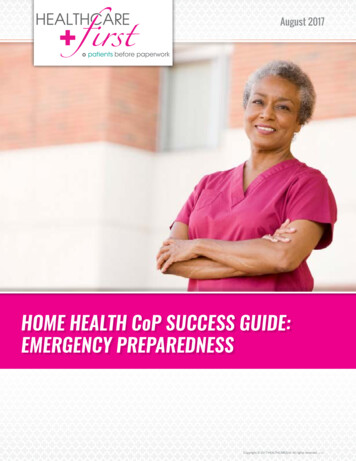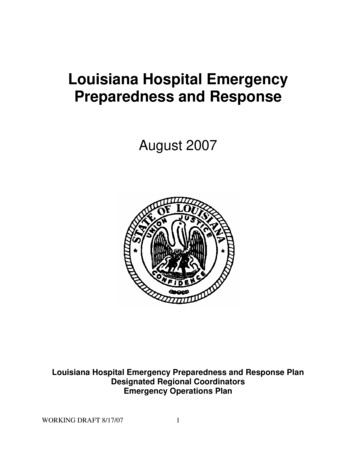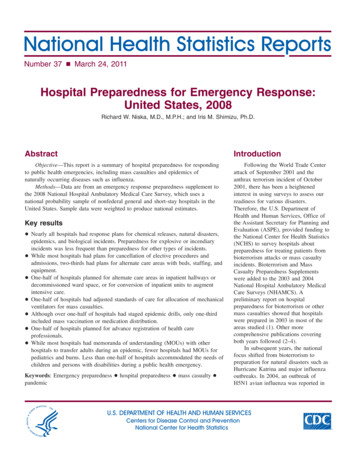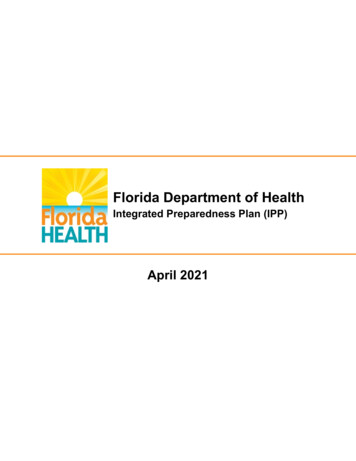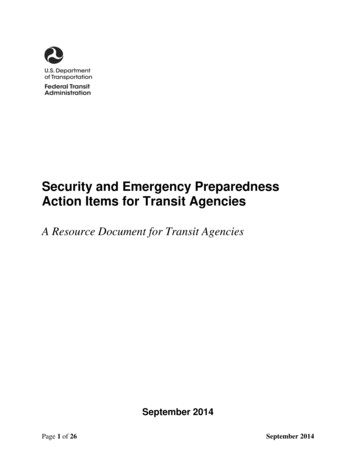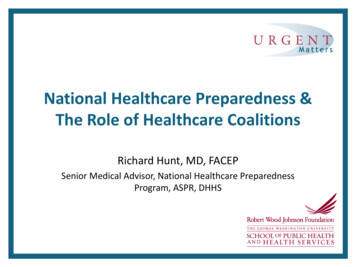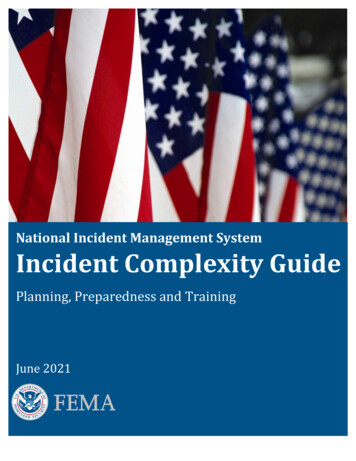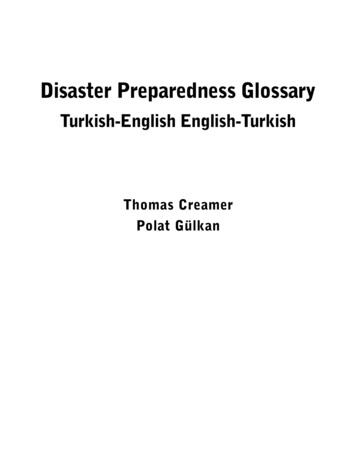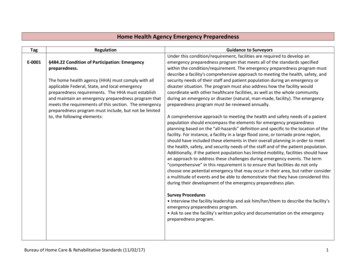
Transcription
Home Health Agency Emergency PreparednessTagE-0001Regulation§484.22 Condition of Participation: Emergencypreparedness.The home health agency (HHA) must comply with allapplicable Federal, State, and local emergencypreparedness requirements. The HHA must establishand maintain an emergency preparedness program thatmeets the requirements of this section. The emergencypreparedness program must include, but not be limitedto, the following elements:Guidance to SurveyorsUnder this condition/requirement, facilities are required to develop anemergency preparedness program that meets all of the standards specifiedwithin the condition/requirement. The emergency preparedness program mustdescribe a facility's comprehensive approach to meeting the health, safety, andsecurity needs of their staff and patient population during an emergency ordisaster situation. The program must also address how the facility wouldcoordinate with other healthcare facilities, as well as the whole communityduring an emergency or disaster (natural, man-made, facility). The emergencypreparedness program must be reviewed annually.A comprehensive approach to meeting the health and safety needs of a patientpopulation should encompass the elements for emergency preparednessplanning based on the “all-hazards” definition and specific to the location of thefacility. For instance, a facility in a large flood zone, or tornado prone region,should have included these elements in their overall planning in order to meetthe health, safety, and security needs of the staff and of the patient population.Additionally, if the patient population has limited mobility, facilities should havean approach to address these challenges during emergency events. The term“comprehensive” in this requirement is to ensure that facilities do not onlychoose one potential emergency that may occur in their area, but rather considera multitude of events and be able to demonstrate that they have considered thisduring their development of the emergency preparedness plan.Survey Procedures Interview the facility leadership and ask him/her/them to describe the facility’semergency preparedness program. Ask to see the facility’s written policy and documentation on the emergencypreparedness program.Bureau of Home Care & Rehabilitative Standards (11/02/17)1
TagE-0004Regulation§484.22 (a) Emergency Plan.The HHA must develop and maintain an emergencypreparedness plan that must be reviewed, and updatedat least annually. The plan must do the following:Guidance to SurveyorsFacilities are required to develop and maintain an emergency preparedness plan.The plan must include all of the required elements under the standard. The planmust be reviewed and updated at least annually. The annual review must bedocumented to include the date of the review and any updates made to theemergency plan based on the review. The format of the emergency preparednessplan that a facility uses is at its discretion.An emergency plan is one part of a facility's emergency preparedness program.The plan provides the framework, which includes conducting facility-based andcommunity-based risk assessments that will assist a facility in addressing theneeds of their patient populations, along with identifying the continuity ofbusiness operations which will provide support during an actual emergency. Inaddition, the emergency plan supports, guides, and ensures a facility's ability tocollaborate with local emergency preparedness officials. This approach is specificto the location of the facility and considers particular hazards most likely to occurin the surrounding area. These include, but are not limited to: Natural disasters Man-made disasters, Facility-based disasters that include but are not limited to:o Care-related emergencies;o Equipment and utility failures, including but not limited to power,water, gas, etc.;o Interruptions in communication, including cyber-attacks;o Loss of all or portion of a facility; ando Interruptions to the normal supply of essential resources, such aswater, food, fuel (heating, cooking, and generators), and in some cases,medications and medical supplies (including medical gases, if applicable).When evaluating potential interruptions to the normal supply of essentialservices, the facility should take into account the likely durations of suchinterruptions. Arrangements or contracts to re-establish essential utility servicesduring an emergency should describe the timeframe within which the contractorBureau of Home Care & Rehabilitative Standards (11/02/17)2
TagRegulationE-0004(continued)Guidance to Surveyorsis required to initiate services after the start of the emergency, how they will beprocured and delivered in the facility’s local area, and that the contractor willcontinue to supply the essential items throughout and to the end of emergenciesof varying duration.Survey Procedures Verify the facility has an emergency preparedness plan by asking to see a copyof the plan. Ask facility leadership to identify the hazards (e.g. natural, man-made, facility,geographic, etc.) that were identified in the facility’s risk assessment and how therisk assessment was conducted. Review the plan to verify it contains all of the required elements Verify that the plan is reviewed and updated annually by looking fordocumentation of the date of the review and updates that were made to the planbased on the reviewE-0006[The plan must do the following:](1) Be based on and include a documented, facilitybased and community based risk assessment, utilizingan all-hazards approach.(2) Include strategies for addressing emergency eventsidentified by the risk assessment.Bureau of Home Care & Rehabilitative Standards (11/02/17)Facilities are expected to develop an emergency preparedness plan that is basedon the facility-based and community-based risk assessment using an “all-hazards”approach. Facilities must document both risk assessments. An exampleconsideration may include, but is not limited to, natural disasters prevalent in afacility’s geographic region such as wildfires, tornados, flooding, etc. An allhazards approach is an integrated approach to emergency preparedness planningthat focuses on capacities and capabilities that are critical to preparedness for afull spectrum of emergencies or disasters. This approach is specific to the locationof the facility considering the types of hazards most likely to occur in the area.Thus, all-hazards planning does not specifically address every possible threat orrisk but ensures the facility will have the capacity to address a broad range ofrelated emergencies. Facilities are encouraged to utilize the concepts outlined inthe National Preparedness System, published by the United States Department ofHomeland Security’s Federal Emergency Management Agency (FEMA), as well asguidance provided by the Agency for Healthcare Research and Quality (AHRQ).3
TagRegulationE-0006(continued)Guidance to Surveyors“Community” is not defined in order to afford facilities the flexibility in decidingwhich healthcare facilities and agencies it considers to be part of its communityfor emergency planning purposes. However, the term could mean entities withina state or multi-state region. The goal of the provision is to ensure thathealthcare providers collaborate with other entities within a given community topromote an integrated response. Conducting integrated planning with state andlocal entities could identify potential gaps in state and local capabilities that canthen be addressed in advance of an emergency.Facilities may rely on a community-based risk assessment developed by otherentities, such as public health agencies, emergency management agencies, andregional health care coalitions or in conjunction with conducting its own facilitybased assessment. If this approach is used, facilities are expected to have a copyof the community-based risk assessment and to work with the entity thatdeveloped it to ensure that the facility’s emergency plan is in alignment.When developing an emergency preparedness plan, facilities are expected toconsider, among other things, the following: Identification of all business functions essential to the facility’s operations thatshould be continued during an emergency; Identification of all risks or emergencies that the facility may reasonably expectto confront; Identification of all contingencies for which the facility should plan; Consideration of the facility’s location; Assessment of the extent to which natural or man-made emergencies maycause the facility to cease or limit operations; and, Determination of what arrangements may be necessary with other health carefacilities, or other entities that might be needed to ensure that essential servicescould be provided during an emergency.In situations where the facility does not own the structure(s) where care isprovided, it is the facility’s responsibility to discuss emergency preparednessconcerns with the landlord to ensure continuation of careBureau of Home Care & Rehabilitative Standards (11/02/17)4
TagRegulationGuidance to Surveyorsif the structure of the building and its utilities are impacted.E-0006(continued)Facilities must develop strategies for addressing emergency events that wereidentified during the development of the facility- and community-based riskassessments. Examples of these strategies may include, but are not limited to,developing a staffing strategy if staff shortages were identified during the riskassessment or developing a surge capacity strategy if the facility has identified itwould likely be requested to accept additional patients during an emergency.Facilities will also want to consider evacuation plans. For example, a facility in alarge metropolitan city may plan to utilize the support of other large communityfacilities as alternate care sites for its patients if the facility needs to beevacuated. The facility is also expected to have a backup evacuation plan forinstances in which nearby facilities are also affected by the emergency and areunable to receive patients.Survey Procedures (E-0006) Ask to see the written documentation of the facility’s risk assessments andassociated strategies. Interview the facility leadership and ask which hazards (e.g. natural, man-made,facility, geographic) were included in the facility’s risk assessment, why they wereincluded and how the risk assessment was conducted. Verify the risk-assessment is based on an all-hazards approach specific to thegeographic location of the facility and encompasses potential hazards.E-0007[The plan must do the following:](3) Address patient population, including, but notlimited to, the type of services the HHA has the ability toprovide in an emergency; and continuity of operations,including delegations of authority and succession plans.Bureau of Home Care & Rehabilitative Standards (11/02/17)The emergency plan must specify the population served within the facility, suchas inpatients and/or outpatients, and their unique vulnerabilities in the event ofan emergency or disaster. A facility’s emergency plan must also address personsat-risk, except for plans of ASCs, hospices, PACE organizations, HHAs, CORFs,CMHCs, RHCs/FQHCs and ESRD facilities. As defined by the Pandemic and AllHazards Preparedness Act (PAHPA) of 2006, members of at-risk populations mayhave additional needs in one or more of the following functional areas:5
TagRegulationE-0007(continued)Guidance to Surveyorsmaintaining independence, communication, transportation, supervision, andmedical care. In addition to those individuals specifically recognized as at-risk inthe PAHPA (children, senior citizens, and pregnant women), “at-risk populations”are also individuals who may need additional response assistance including thosewho have disabilities, live in institutionalized settings, are from diverse culturesand racial and ethnic backgrounds, have limited English proficiency or are nonEnglish speaking, lack transportation, have chronic medical disorders, or havepharmacological dependency. At-risk populations would also include, but are notlimited to, the elderly, persons in hospitals and nursing homes, people withphysical and mental disabilities as well as others with access and functionalneeds, and infants and children.Mobility is an important part in effective and timely evacuations, and thereforefacilities are expected to properly plan to identify patients who would requireadditional assistance, ensure that means for transport are accessible andavailable and that those involved in transport, as well as the patients andresidents are made aware of the procedures to evacuate. For outpatient facilities,such as Home Health Agencies (HHAs), the emergency plan is required to ensurethat patients with limited mobility are addressed within the plan.The emergency plan must also address the types of services that the facilitywould be able to provide in an emergency. The emergency plan must identifywhich staff would assume specific roles in another’s absence through successionplanning and delegations of authority. Succession planning is a process foridentifying and developing internal people with the potential to fill key businessleadership positions in the company. Succession planning increases theavailability of experienced and capable employees that are prepared to assumethese roles as they become available. During times of emergency, facilities musthave employees who are capable of assuming various critical roles in the eventthat current staff and leadership are not available. At a minimum, there shouldbe a qualified person who "is authorized in writing to act in the absence of theadministrator or person legally responsible for the operations of the facility."Bureau of Home Care & Rehabilitative Standards (11/02/17)6
TagRegulationE-0007(continued)Guidance to SurveyorsIn addition to the facility- and community-based risk assessment, continuity ofoperations planning generally considers elements such as: essential personnel,essential functions, critical resources, vital records and IT data protection,alternate facility identification and location, and financial resources. Facilities areencouraged to refer to and utilize resources from various agencies such as FEMAand Assistant Secretary for Preparedness and Response (ASPR) when developingstrategies for ensuring continuity of operations. Facilities are encouraged to referto and utilize resources from various agencies such as FEMA and ASPR whendeveloping strategies for ensuring continuity of operations.Survey Procedures (E-0007)Interview leadership and ask them to describe the following: The facility’s patient populations that would be at risk during an emergencyevent; Services the facility would be able to provide during an emergency; How the facility plans to continue operations during an emergency; Delegations of authority and succession plans.Verify that all of the above are included in the written emergency plan.E-0009[The plan must do the following:](4) Include a process for cooperation and collaborationwith local, tribal, regional, State, or Federal emergencypreparedness officials' efforts to maintain an integratedresponse during a disaster or emergency situation,including documentation of the HHA's efforts to contactsuch officials and, when applicable, of its participation incollaborative and cooperative planning efforts.While the responsibility for ensuring a coordinated disaster preparednessresponse lies upon the state and local emergency planning authorities, the facilitymust document its efforts to contact these officials to engage in collaborativeplanning for an integrated emergency response. The facility must include thisintegrated response process in its emergency plan. Facilities are encouraged toparticipate in a healthcare coalition as it may provide assistance in planning andaddressing broader community needs that may also be supported by local healthdepartment and emergency management resources.Survey Procedures Interview facility leadership and ask them to describe their process forensuring cooperation and collaboration with local, tribal, regional, State, andBureau of Home Care & Rehabilitative Standards (11/02/17)7
TagE-0009Regulation(continued)E-0013§484.22 (b) Policies and Procedures.The HHA must develop and implement emergencypreparedness policies and procedures, based on theemergency plan set forth in paragraph (a) of thissection, risk assessment at paragraph (a)(1) of thissection, and the communication plan at paragraph (c) ofthis section. The policies and procedures must bereviewed and updated at least annually.At a minimum the policies and procedures must addressthe following:Guidance to SurveyorsFederal emergency preparedness officials' efforts to ensure an integratedresponse during a disaster or emergency situation. Ask for documentation of the facility's efforts to contact such officials and,when applicable, its participation in collaborative and cooperative planningefforts.Facilities must develop and implement policies and procedures per therequirements of this standard. The policies and procedures are expected to alignwith the identified hazards within the facility’s risk assessment and the facility’soverall emergency preparedness program.We are not specifying where the facility must have the emergency preparednesspolicies and procedures. A facility may choose whether to incorporate theemergency policies and procedures within their emergency plan or to be part ofthe facility’s Standard Operating Procedures or Operating Manual. However, thefacility must be able to demonstrate compliance upon survey, therefore werecommend that facilities have a central place to house the emergencypreparedness program documents (to include all policies and procedures) tofacilitate review.Survey ProceduresReview the written policies and procedures which address the facility’semergency plan and verify the following: Policies and procedures were developed based on the facility- and communitybased risk assessment and communication plan, utilizing an all-hazards approach. Ask to see documentation that verifies the policies and procedures have beenreviewed and updated on an annual basis.Bureau of Home Care & Rehabilitative Standards (11/02/17)8
TagE-0017Regulation[At a minimum, the policies and procedures mustaddress the following:](1) The plans for the HHA’s patients during a natural orman-made disaster. Individual plans for each patientmust be included as part of the comprehensive patientassessment, which must be conducted according to theprovisions at §484.55.Guidance to SurveyorsHHAs must include policies and procedures in its emergency plan for ensuring allpatients have an individualized plan in the event of an emergency. That plan mustbe included as part of the patient’s comprehensive assessment.For example, discussions to develop individualized emergency preparednessplans could include potential disasters that the patient may face within the homesuch as fire hazards, flooding, and tornados; and how and when a patient is tocontact local emergency officials. Discussions may also include patient, careproviders, patient representative, or any person involved in the clinical careaspects to educate them on steps that can be taken to improve the patient’ssafety. The individualized emergency plan should be in writing and could be assimple as a detailed emergency card to be kept with the patient. HHA personnelshould document that these discussions occurred and also keep a copy of theindividualized emergency plan in the patient’s file as well as provide a copy to thepatient and or their caregiver.Survey Procedures Through record review, verify that each patient has an individualizedemergency plan documented as part of the patient’s comprehensive assessment.E-0019[At a minimum, the policies and procedures mustaddress the following:](2) The procedures to inform state and local (emergencypreparedness) officials about HHA patients in need ofevacuation from their residences at any time due to anemergency situation based on the patient's medical andpsychiatric condition and home environment.Bureau of Home Care & Rehabilitative Standards (11/02/17)Home bound hospices, HHAs and PACE organizations are required to inform Stateand local emergency preparedness officials of the need for patient evacuations.These policies and procedures must address when and how this information iscommunicated to emergency officials and also include the clinical care neededfor these patients. For instance, in the event an in-home hospice, PACEorganization or HHA patient requires evacuation, the responsible agency shouldprovide emergency officials with the appropriate information to facilitate thepatient’s evacuation and transportation. This should include, but is not limited to,the following: Whether or not the patient is mobile. What type of life-saving equipment does the patient require?9
TagRegulationE-0019(continued)Guidance to Surveyors Is the life-saving equipment able to be transported? (E.g., Battery operated,transportable, condition of equipment, etc.) Does the patient have special needs? (E.g., Communication challenges,language barriers, intellectual disabilities, special dietary needs, etc.)Since such policies and procedures include protected health information ofpatients, facilities must also ensure they are in compliance with applicable theHealth Insurance Portability and Accountability Act (HIPAA) Rules at 45 CFR parts160 and 164, as appropriate. See (81 FR 63879, Sept. 16, 2016).Survey Procedures Review the emergency plan to verify it includes procedures to inform State andlocal emergency preparedness officials about patients in need of evacuation fromtheir residences at any time due to an emergency situation based on the patient’smedical and psychiatric condition and home environment.E-0021[At a minimum, the policies and procedures mustaddress the following:](3) The procedures to follow up with on-duty staff andpatients to determine services that are needed, in theevent that there is an interruption in services during ordue to an emergency. The HHA must inform State andlocal officials of any on-duty staff or patients that theyare unable to contact.Bureau of Home Care & Rehabilitative Standards (11/02/17)HHAs must include in its emergency plan, procedures required of this standard.During an emergency, if a patient requires care that is beyond the capabilities ofthe HHA, there is an expectation that care of the patient would be rearranged orsuspended for a period of time, as most HHAs in general would not necessarilytransfer patients to other HHAs during an emergency.HHAs policies and procedures should clearly outline what surrounding facilities,such as a hospital or a nursing home, it has a transfer arrangement with to ensurepatient care is continued. Additionally, these policies and procedures shouldoutline timelines for transferring patients or under what conditions patientswould need to move. For instance, if the emergency is one which only isanticipated to have one or two days of disruption and does not pose immediatethreat to patient health or safety (in which then the HHA should immediatelytransfer the patient); the HHA may rearrange services, whereas if a disaster isanticipated to last over one week or more, the HHA may need to initiate transferof a patient as soon as possible. The policies and procedures should addressthese events.10
TagRegulationE-0021(continued)Guidance to SurveyorsAdditionally, the HHAs’ policies and procedures must address what actions wouldbe required due to the inability to make contact with staff or patients andreporting capabilities to the local and State emergency officials.Survey Procedures Verify that the HHA has included in its emergency plan these procedures tofollow-up with staff and patients and to inform state and local authorities whenthey are unable to contact any of them. Verify that the HHA has procedures in its emergency plan to follow up with on‐duty staff and patients to determine the services that are needed, in the eventthat there is an interruption in services during or due to an emergency. Ask the HHA to describe the mechanism to inform State and local officials ofany on‐duty staff or patients that they are unable to contact.E-0023[At a minimum, the policies and procedures mustaddress the following:](4) A system of medical documentation that preservespatient information, protects confidentiality of patientinformation, and secures and maintains the availabilityof records.In addition to any existing requirements for patient records found in existinglaws, under this standard, facilities are required to ensure that patient recordsare secure and readily available to support continuity of care during emergency.This requirement does not supersede or take away any requirements foundunder the provider/supplier’s medical records regulations, but rather, thisstandard adds to such policies and procedures. These policies and proceduresmust also be in compliance with the Health Insurance Portability andAccountability Act (HIPAA), Privacy and Security Rules at 45 CFR parts 160 and164, which protect the privacy and security of individual’s personal healthinformation.Survey Procedures Ask to see a copy of the policies and procedures that documents the medicalrecord documentation system the facility has developed to preserves patientinformation, protects confidentiality of patient information, and secures andmaintains availability of records.Bureau of Home Care & Rehabilitative Standards (11/02/17)11
TagE-0024Regulation[At a minimum, the policies and procedures mustaddress the following:](5) The use of volunteers in an emergency or otheremergency staffing strategies, including the process androle for integration of State and Federally designatedhealth care professionals to address surge needs duringan emergency.Guidance to SurveyorsDuring an emergency, a facility may need to accept volunteer support fromindividuals with varying levels of skills and training. The facility must have policiesand procedures in place to facilitate this support. In order for volunteeringhealthcare professionals to be able to perform services within their scope ofpractice and training, facilities must include any necessary privileging andcredentialing processes in its emergency preparedness plan policies andprocedures. Non-medical volunteers would perform non-medical tasks. Facilitieshave flexibility in determining how best to utilize volunteers during an emergencyas long as such utilization is in accordance with State law, State scope of practicerules, and facility policy. These may also include federally designated health careprofessionals, such as Public Health Service (PHS) staff, National Disaster MedicalSystem (NDMS) medical teams, Department of Defense (DOD) Nurse Corps,Medical Reserve Corps (MRC), or personnel such as those identified in federallydesignated Health Professional Shortage Areas (HPSAs) to include licensedprimary care medical, dental, and mental/behavioral health professionals.Facilities are also encouraged to integrate State-established volunteer registries,and where possible, State-based Emergency System for Advanced Registration ofVolunteer Health Professionals (ESAR-VHP).Facilities are expected to include in its emergency plan a method for contactingoff-duty staff during an emergency and procedures to address othercontingencies in the event staff are not able to report to duty which may include,but are not limited to, utilizing staff from other facilities and state or federallydesignated health professionals.Survey Procedures Verify the facility has included policies and procedures for the use of volunteersand other staffing strategies in its emergency plan.Bureau of Home Care & Rehabilitative Standards (11/02/17)12
TagE-0029Regulation§484.113 (c) Communication plan.The HHA must develop and maintain an emergencypreparedness communication plan that complies withFederal, State and local laws and must be reviewed andupdated at least annually. The communication planmust include all of the following:Guidance to SurveyorsFacilities must have a written emergency communication plan that contains howthe facility coordinates patient care within the facility, across healthcareproviders, and with state and local public health departments. Thecommunication plan should include how the facility interacts and coordinateswith emergency management agencies and systems to protect patient health andsafety in the event of a disaster. The development of a communication plan willsupport the coordination of care. The plan must be reviewed annually andupdated as necessary. We are allowing facilities flexibility in how they formulateand operationalize the requirements of the communication plan.Facilities in rural or remote areas with limited connectivity to communicationmethodologies such as the Internet, World Wide Web, or cellular capabilitiesneed to ensure their communication plan addresses how they wouldcommunicate and comply with this requirement in the absence of thesecommunication methodologies. For example, if a facility is located in a rural area,which has limited or no Internet and phone connectivity during an emergency, itmust address what alternate means are available to alert local and Stateemergency officials. Optional communication methods facilities may considerinclude satellite phones, radios and short wave radios.Survey Procedures Verify that the facility has a written communication plan by asking to see theplan. Ask to see evidence that the plan has been reviewed (and updated asnecessary) on an annual basis.Bureau of Home Care & Rehabilitative Standards (11/02/17)13
TagE-0030Regulation[ The communication plan must include all of thefollowing:](1) Names and contact information for the following:(i) Staff(ii) Entities providing services und
business operations which will provide support during an actual emergency. In addition, the emergency plan supports, guides, and ensures a facility's ability to collaborate with local emergency preparedness officials. This approach is specific to the location of the facility and considers particular hazards most likely to occur
